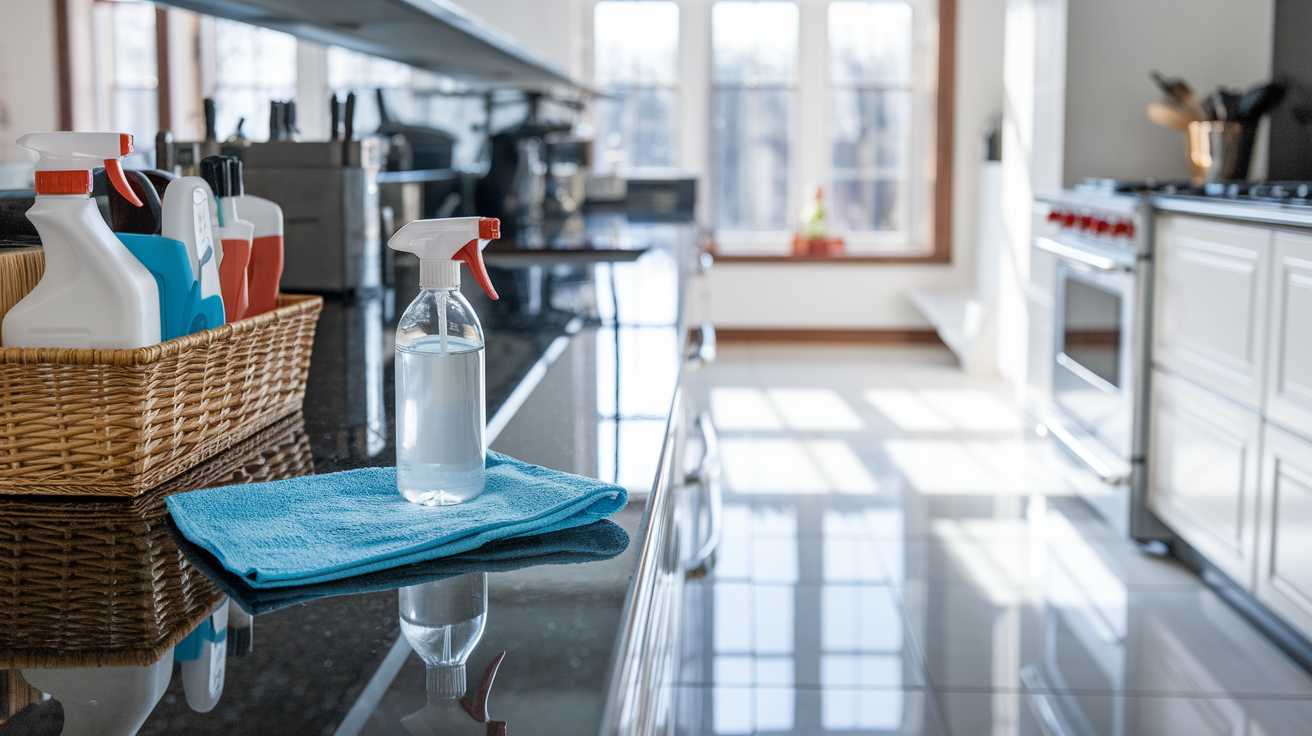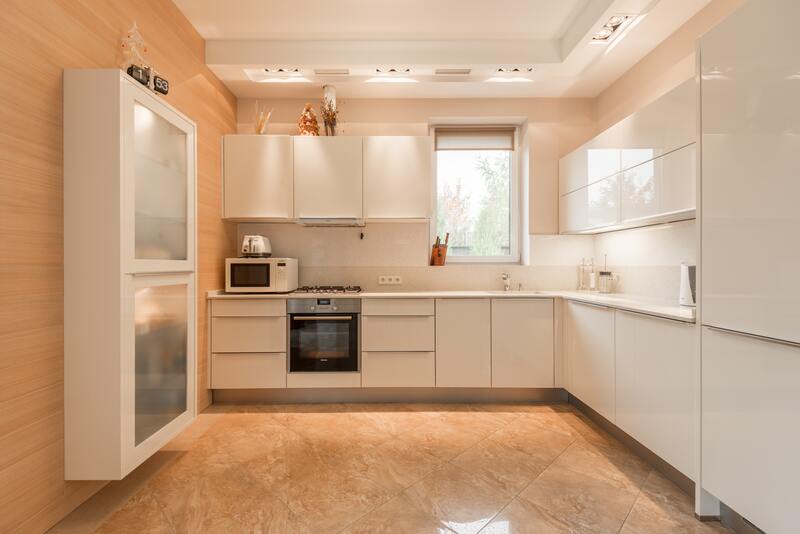Ever clean your kitchen for two hours and still see that one stain staring up at you? Yeah, me too. Nothing’s as aggravating as spending all that elbow grease and toil for a bunch of ho-hum.
But there’s one problem: Most of us are doing it the wrong way. Completely wrong. Remember those kitchen cleaning tips your mom taught you? Most of them are either out-of-date or not that effective in the first place.
I’ve tried dozens of kitchen cleaning methods, from greasy stovetops to dirty floors. The divide between what works and what people think does is truly staggering.
What if you also knew that the key to cleaner countertops isn’t purchasing expensive cleaners, but understanding the science behind various surfaces? And that’s only the start of it…
Essential Cleaning Supplies for a Spotless Kitchen
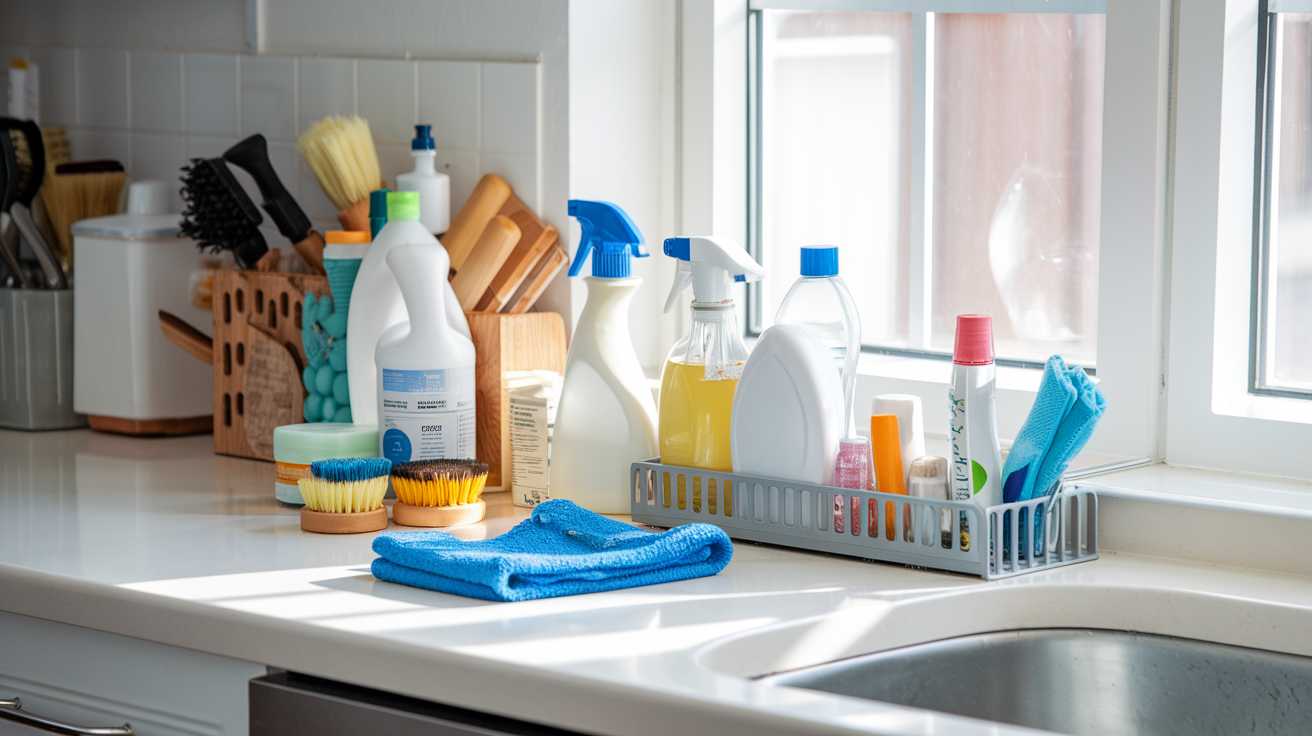
Natural and Chemical Cleaners: Which Cleans Better?
Have you ever wondered if those natural cleaners work? I have given both sides an extensive workout, and this is the truth: both deserve a place in your kitchen cleaning routine.
Vinegar, baking soda, and lemon do an amazing job cleaning when:
- You’re scrubbing down every day’s messes
- You send in sensitive skin score, or respiratory, in the triggering term, temperament, or both.
- Kids or pets are running about
- You want to save serious cash
When it comes to the crown, chemical cleaners win when:
- You’ve had that stovetop pasta sauce crust for eons.
- After you handle raw meat, you should disinfect.
- Your stubborn, built-up grease is no match.
- You’re in a hurry, you’ve got no time to lose
For granite countertops, leave out the vinegar (it can etch the stone). After all, it’s Mother Nature we’re dealing with, people! Instead, add some mild dish soap to a warm water solution, or use a pH-neutral cleaner made for stone. Quartz will cut you some slack, but deserves kind treatment nonetheless — nothing super acidic or abrasive.
Because in the end, the war is not natural vs. chemical — it’s about choosing the appropriate product for the job at hand. Before you choose to live in a quotation mark, a well-thought-out mix of both worlds would do most kitchens a favor.
Must-Have Tools That Save Time and Effort
The correct tools can help make a hated kitchen deep-clean something less than completely unmanageable. I’m not kidding.
These game-changers have earned their spot in your cleaning caddy:
- Microfiber cloths: They get grease, dust, and grime like nobody’s business. Ideal for stainless steel appliances without streaking.
- Silicone scraper: Use it to scrape off crusted-over food from surfaces without scratching. Works miracles on stovetops.
- Extendable duster: Reaches those dusty, grease-filled nooks above cabinets where filth gathers to plot terror.
- Quality squeegee: You can use it for more than windows! For use on backsplashes and counters for streak-free shine.
- Grout brush: That toothbrush isn’t cutting it. The stiff bristles of a good grout brush can make your tile floors look like new.
- Steam cleaner: Your ultimate multitasker. Cleans floors, is great at loosening grime on appliances, and makes grout sparkle without any chemicals.
For kitchen floors, particularly, purchase a nice microfiber mop with washable pads. They pick up dirt more effectively than standard string mops and don’t merely push the grime around.
To make your kitchen even more efficient, consider adding some of these modular kitchen accessories that pair perfectly with your cleaning routine.
Budget-Friendly Cleaning Solutions You Can Make at Home
Because why spend $30 on special cleaners when the ones in your pantry work just as well? And homemade solutions are often more effective than store-bought offerings.
All-Purpose Kitchen Cleaner:
Combine white vinegar and water in a spray bottle in equal parts. Include 10 drops of essential oil (lemon or tea tree) if you find the vinegar scent unbearable. Tackles counters, tables, and nearly all other household or kitchen surfaces except natural stone.
Granite & Quartz Cleanser to Keep You Safe:
Combine 1/4 cup of rubbing alcohol, 3 drops of dish soap, and 2 cups of water. It won’t harm stone surfaces, but it still disinfects and cleans like a charm.
Powerful Degreaser:
Combine 1/4 cup baking soda, 1 tablespoon dish soap, and warm water, mixing into a paste. This is some stuff that decimates grease on stovetops and hood vents.
Natural Kitchen Disinfectant:
Combine 1 cup water, 1/4 cup hydrogen peroxide, and 10 drops of lemon essential oil. Spray, then allow to rest for 10 minutes before wiping.
Burnt Stove Surface Cleaner:
Bake a soda and water paste. Wash and use as a wash: Apply to scorched area, let it stand overnight, then in the morning wipe off the loosened spots.
These are pennies compared to store-bought solutions, and you’ll never run out in the middle of a cleaning session.
How To Organize Cleaning Supplies To Get The Most Out Of Them
The magic of clean kitchens isn’t a miracle product at all, but rather organization. You’ll always put it off when your cleaning supplies are in disarray under your sink.
Make a cleaning caddy you can grab and go. Include:
- All-purpose spray
- Glass cleaner
- Degreaser
- Disinfectant
- 3-4 microfiber cloths
- Scrub brush
- Silicone scraper
Keep specialty cleaners (those stone-safe formulas for counter tops or stainless steel polish, among them) in a second bin, but within easy reach.
Under your sink, put in a tension rod to suspend spray bottles. This allows for bulkier items to rest on the floor with no tipping.
Label everything clearly. You leave the family members to clean the house, and there’s no excuse for wrecking the imported, costly countertops.
Organize supplies by cleaning area—countertop cleaners, floor care products, and appliance supplies—so you don’t have to dig through everything to find what you need. A few smart adjustments can help you maximize your modular kitchen cabinet space and keep daily essentials within easy reach.
The smartest cleaning hack? A laminated kitchen cleaning schedule is stapled inside a cabinet door. Now you’ll never forget to wipe out the microwave or sweep under the fridge!
Countertop Cleaning Strategies by Material
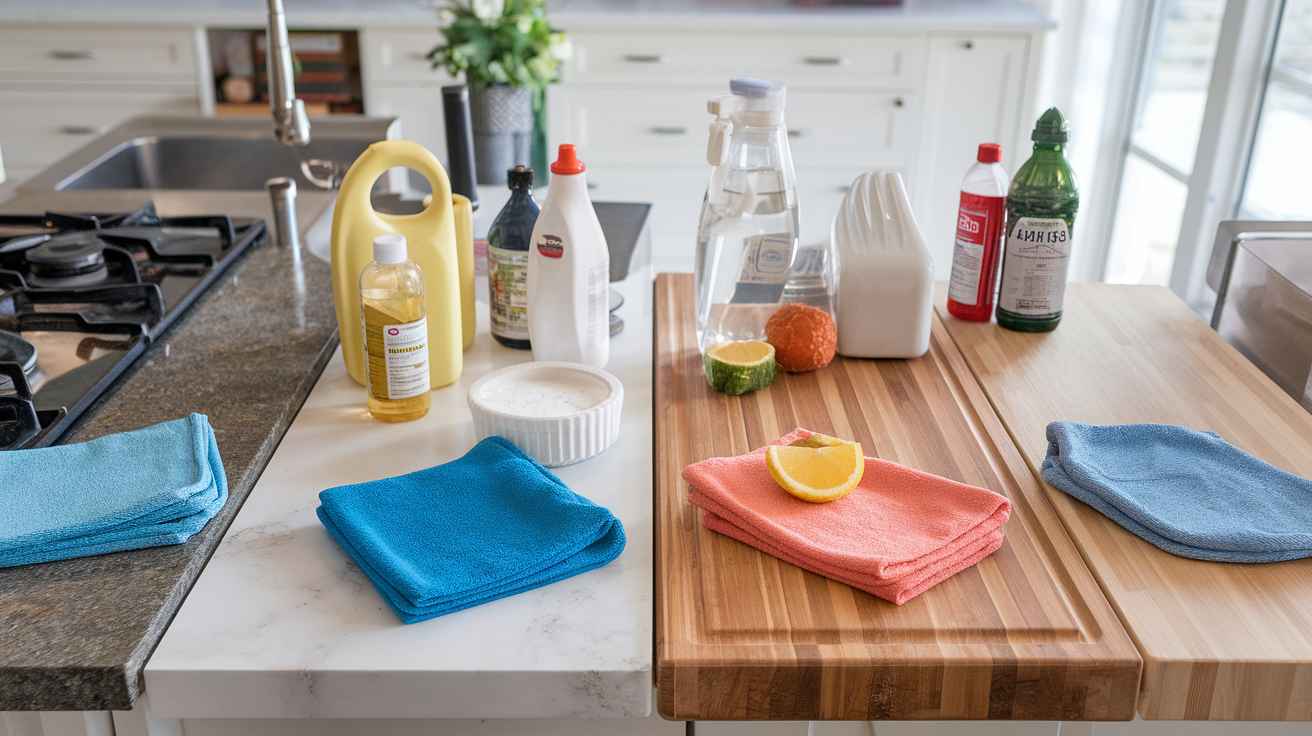
Granite and Marble Care: Protecting Natural Stone
Have natural stone countertops? Lucky you—they’re gorgeous! But they need extra care. Do not use vinegar, lemon, or anything acidic on marble or granite — that’s a rookie mistake that leaves etching you can’t do anything about.
What works instead? Daily cleaning is taken care of with a warm water-dampened microfiber cloth. For a deeper clean, pull out a pH-neutral stone cleaner. Prevention is always best, though: Wipe up spills right away, especially those from red wine, coffee, and tomato sauce.
Pro tip: Reseal your granite or marble every 6-12 months. Liquid should bead up on a properly sealed surface. If it absorbs, it’s time to seal.
Quartz and Solid Surface Care: Easy as One, Two, Three
Quartz, the no-maintenance superstar of countertops. No sealing required! For day-to-day cleaning, soap and warm water, and a soft cloth are all you need.
For really bad spots, attempt this trick: Mix baking soda with water to form a paste, apply to the stain, cover with plastic wrap, then leave it alone overnight. Wipe clean in the morning.
What to avoid? Do not use abrasive pads or cleaning products with harsh chemicals — they will dull the surface over the years. And keep using trivets, even though quartz is heat-resistant. Why risk it?
Butcher Block and Wood Surfaces: Preventing Stains and Bacteria
Wood slab countertops bring a warm, cozy feel to any space, but can also show wear and tear quickly. Wipe your butcher block down with mild dish soap and water after cooking, and always use a damp cloth to clean the surface, drying immediately (because wood and water are not friends).
To maintain food safety, clean monthly with a combination of 1 tablespoon of bleach mixed with 1 gallon of water. Let stand 5 minutes, then rinse thoroughly, and let air dry.
Once a month, oil your butcher block with food-grade mineral oil (not cooking oil; it’ll turn rancid). Spread on liberally, let sit for 20 minutes, then wipe off any excess. This will help you avoid cracks, and your wood will remain beautiful.
For tough stains, sand lightly with fine-grit sandpaper and re-oil.
Laminate and Tile: Quick Daily Cleaning Methods
Laminate countertops are the workhorses of kitchens everywhere. For daily cleaning, a microfiber cloth with warm, soapy water does the trick.
Tile counters and backsplashes. Grout is the most common hiding place for grime on tile. Mix a paste of baking soda and water, scrub grout with an old toothbrush, and rinse.
A steam cleaner, however, works wonders on both surfaces when you’d like a little deeper clean without the use of chemicals.
Avoid using abrasive cleaners on laminate — they’ll scratch the surface. And don’t ever put bleach on colored grout unless you’re now in the market for a whole new color scheme!
Getting Rid of Tough Stains Without the Damage
Kitchen counters can receive some tough stains, but don’t grab those harsh chemicals right away.
For coffee or tea stains on most surfaces, make a paste of baking soda and hydrogen peroxide. Spread on, wait five minutes, wipe off.
Oil stains? Dust with cornstarch, leave overnight so it can absorb the oil, and rinse out as usual.
Rust Stains on Quartz or Laminate? A paste of cream of tartar and lemon juice, perhaps (not on natural stone!).
If you have burned-on food, give this a shot: Dampen the burned area, sprinkle baking soda on it, cover with a wet rag for an hour, then wipe flushed with a cloth. The stain practically jumps off itself!
Appliance Cleaning Shortcuts
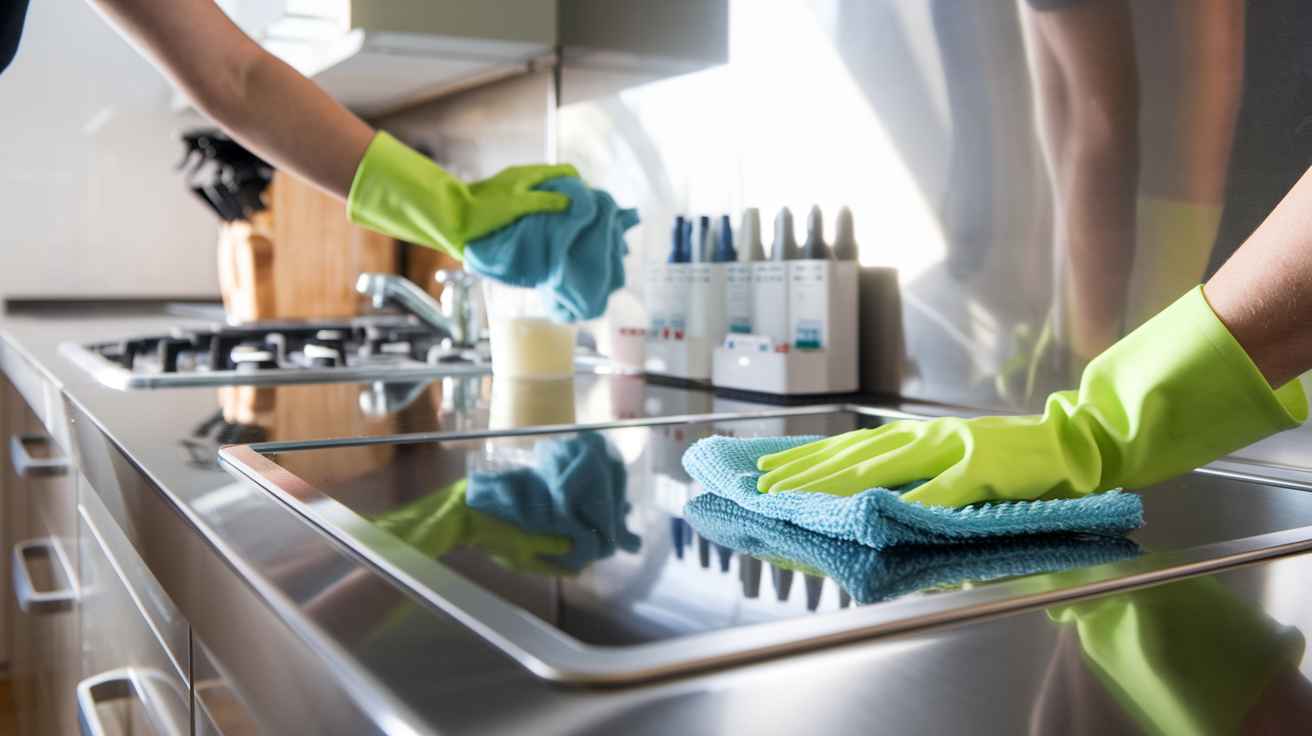
Microwave Magic: Steam Cleaning in Minutes
When it comes to housecleaning, cleaning a crusty microwave is near the top of the list of least-favorite chores, right next to scrubbing toilets. But here’s a game-changer: your microwave can more or less clean itself.
Take a microwave-safe bowl, fill it halfway with water, and squeeze the juice of half a lemon (or one tablespoon of vinegar if lemons aren’t in the fridge). Microwave the bowl for 5 minutes, then leave it to stand, with the door shut, for a further 5 minutes. The steam loosens all that splattered food, and you can simply wipe it away with a cloth. No scrubbing needed!
For stubborn spots? Soak your cloth in the hot lemon water and give it a speedy wipe. Done in literally minutes.
Refrigerator Reset: Organizing and Deep Cleaning
Your refrigerator shouldn’t smell like a failed science experiment. Begin by throwing out old food (we all have one of those mystery containers from three months ago).
Combine equal parts warm water and white vinegar in a spray bottle for a natural disinfectant solution that won’t leave lingering chemical residue near your food. Take out shelves and drawers, give them a spray and let them come to room temperature before washing — a cold glass shelf can break with hot water.
Pro tip: Line your crisper drawers with paper towels to catch spills and speed up cleaning for next time. And that box of baking soda? It does work to take odors, but it only lasts about 30 days. Date stamp —date it so you’ll know when to change it.
Oven Cleaning Without Harsh Chemicals
Standard oven cleaners have this toxic stench because, well, they are kind of toxic. But you can achieve those results safely.
Combine ½ cup baking soda with enough water to form a paste. Spread it around the inside of your oven (not around the heating elements) and leave it overnight. The next morning, spray white vinegar over the dried paste — it will foam up, dissolving the burnt-on nastiness. Wipe it all off with a damp cloth.
For gas stove burners, remove the grates and soak them in hot, soapy water with a generous squirt of ammonia. They will clean themselves while you snooze.
Dishwasher Maintenance for Better Performance
Your dishwasher also requires cleaning. Ironic, right?
A little monthly maintenance will no doubt obstruct funky smells and ensure you’re dishes are getting clean 0done, not-so-much. Take out the filter at the bottom (yes, it’s a thing, and yes, it’ll be disgusting).
Empty a cup of white vinegar in a dishwasher-safe container on the top rack and run a 100-percent empty cycle. Follow that with the below wrung-out sponge run through another empty cycle, this time with a tablespoon of baking soda sprinkled around in the bottom.
Inspect the spray arms for food remnants that may be blocking the holes (a toothpick is great for dislodging any buildup). Your dishes will emerge sparkling, and you’ll also help to prolong the life of your dishwasher.
Cabinet and Drawer Revival
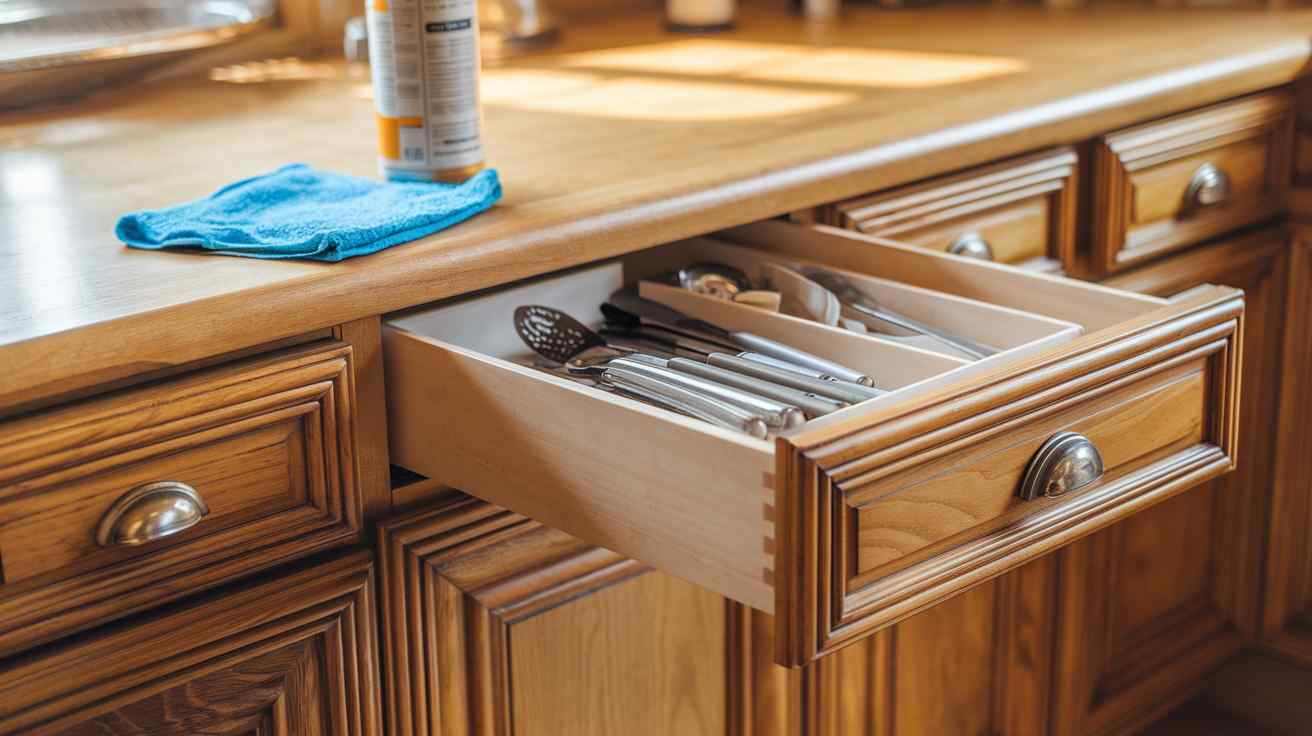
Degreasing Wood Cabinets Without Damaging Finishes
Your kitchen cabinets can get pretty nasty, covered in cooking grease and dried food spills. It took dozens of cleaners until I had one that worked. Combine equal parts white vinegar and warm water along with a drop of dish soap. Dip a soft rag, wring well, and wipe with the grain. The vinegar goes to work cutting the grease, while the minimal amount cats the shine of your finish. For more targeted results, especially in tricky corners or shelf areas, here are some tips on cleaning modular kitchen racks effectively.
For stubborn spots? Baking soda paste. Just whatever you do, don’t polish too hard —you’ll regret it when you notice the scratches.
Organizing Solutions That Keep Cabinets Cleaner Longer
Ever cleaned out your cabinets only to have them look a mess again a few days later? Been there. Game-changer: shelf dividers and stackable organizers. They keep things from sticking to the cabinet and are easy to clean.
Smart tip: Store your frequently used items at eye level and keep like items together. When everything has a proper place, there’s less shuffling (and thus less dirt and fewer fingerprints).
Tackling Sticky Residue and Fingerprints
The sticky mystery film that forms on cabinet handles? It’s a combination of cooking oil and hand oil. A microfiber cloth dipped in a drop of olive oil will break through the gunk. Rub with a clean cloth and wipe off the excess oil.
A 50/50 mixture of water and isopropyl alcohol performs wonders on fingerprints on shiny cabinets. Spray on your cloth (never directly onto the wood) and say goodbye to those prints.
Liner Options That Simplify Future Cleaning
Forget those old-school paper liners that cling to crumbs and soak up spills. Washable silicone liners are the solution. They catch drips, help prevent scratches to the bottom of cabinets, and wash clean in seconds.
Of the best drawer liners, options that grip but are not adhesive stick in place and won’t harm surfaces. Textured so things don’t slide around, leading to less cabinet-bottom scouring.
Floor Cleaning Techniques That Work

A. Tile and Grout Restoration Methods
Kitchen tile floors work hard. I’ve attempted everything from A to Z, and in case you were wondering… mixing baking soda with hydrogen peroxide and a tiny bit of water into a paste can do wonders for some dirty grout. • Apply it, leave on for 10 minutes, and scrub with an old toothbrush. The contrast can be like night and day.
To clean stubborn grout stains, steam, then scrub. It takes the heat to break everything free and makes your job a lot easier.
B. Hardwood Floor Care Without Streaks
How to get streak-free hardwood? Less is more. “Most people are using way too much product. Dampen your mop and wipe along the grain, in a non-circular motion. For a cheap, make-it-yourself alternative, combine one part vinegar with ten parts warm water — it works wonders, doesn’t contain any of the impressive solvents that fancy glass cleaners do, and won’t cost you a thing.
C. Vinyl and Laminate: Quick Mop Solutions
Some floorings are crazy-forgiving, but they’re not self-cleaning. Just say no to harsh chemicals — over time, these will dull the finish. Just use a microfiber mop, warm water, and a drop of dish soap. For extra dirty floors, add a little splash of white vinegar.
D. Spot Treatment for Common Kitchen Spills
- Tomato sauce splatter? Blot don’t rub! Then hit it with club soda instantly.
- Oil spills are tricky. First, sprinkle it with cornstarch or flour to soak up the grease, then wash as usual.
- Wine spills? Salt immediately! It will soak up the liquid before it can set.
E. Time-Saving Floor Maintenance Schedule
- Daily: Lightly sweep or vacuum when things get off track in those well-travelled areas.
- Weekly: Completely mop with a proper cleanser
- Monthly: Once a month, go over the grout lines and borders with a deep-clean solution
- Quarterly: Polish wood or reseal as necessary
This way, there is no buildup, and it saves time in the long run.
Daily Habits for a Perpetually Clean Kitchen
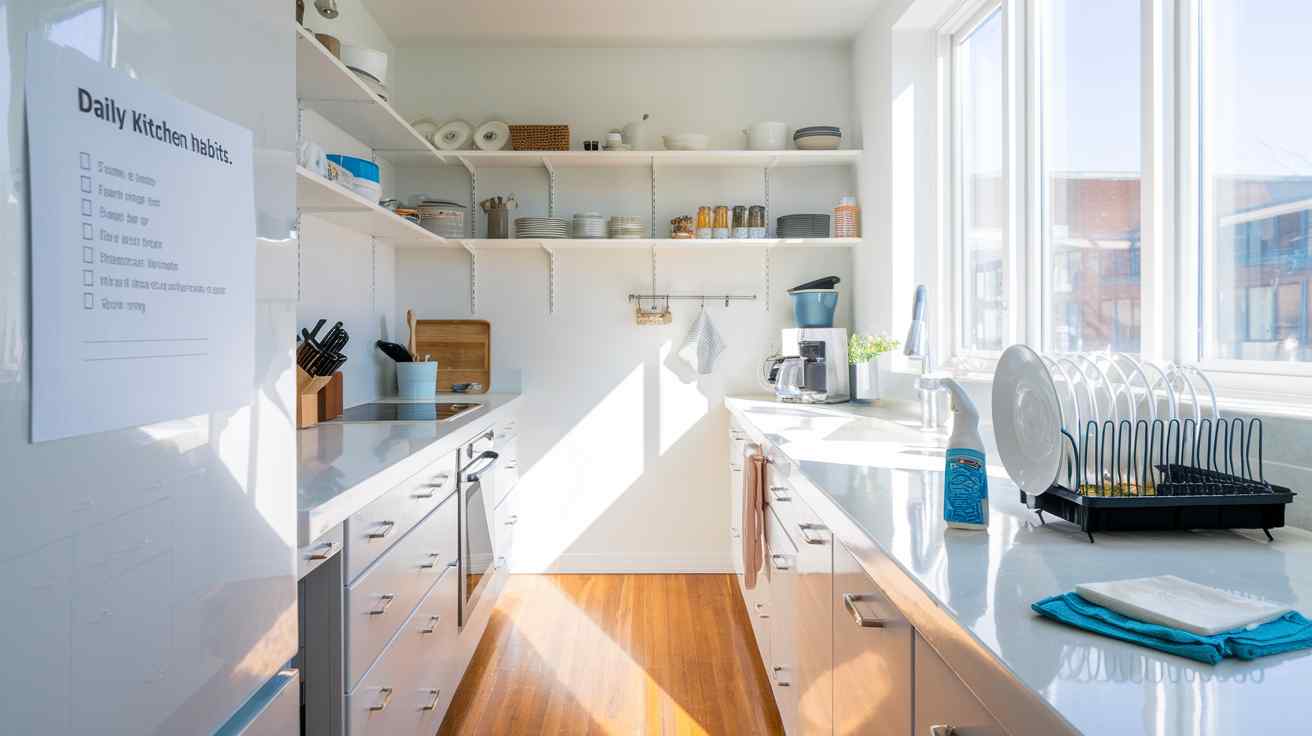
Five-Minute Cleaning Routines Between Meals
You don’t want the kitchen taking over half your weekend. I’ve got some fast fixes that’ll help you stay organized without taking all day:
- Wipe countertops after each meal prep with a microfiber cloth
- Wash dishes immediately or place them in the dishwasher
- Clean up spills as they occur (to prevent scrubbing stubborn, dried ones later)
- Sweep high-traffic floor areas
- Clean up fingerprints on stainless steel appliance fronts with a dry towel
Pro tip: Store a small handmade caddy of cleaning essentials within reach. Snatch one small task when you have a spare minute while the coffee’s brewing or the water is boiling. A great gift for the future you.
Smart Storage Solutions That Prevent Messes
The best cleaning tip? Avoid the Muck in the First Place. Try these storage tricks:
- Pour pantry goods into clear containers to keep spills at bay
- Keep cooking tools in a large mason jar near the stove
- Put hooks under cabinets for mugs and measuring cups
- Have drawer dividers for utensils and tools
- Organize cutting boards by standing them up with tension rods
I began keeping my most-used spices in magnetic tins on the side of my refrigerator, no longer cluttering up my counters with a shuffling rotation of bottles, and my counters were suddenly tidier than ever.
Enlisting Family Help With Simple Systems
It feels so much easier to keep a clean kitchen when everyone is helping out. Here’s what works:
- Design a chore chart for kids that focuses on tasks customized to their age
- Create labeled bins to sort recycling, compost, and trash
- Create a “one touch” rule – everything belongs in its home immediately
- Institute a 10-minute evening “reset” in which everyone takes on a small chore
- Make a game of cleaning (racing the clock works well with children
How to Avoid the Common Kitchen-cleaning Disasters
An ounce of prevention is worth hours of scrubbing:
- Line refrigerator shelves with plastic wrap for easy clean-up
- Fry Foods with A Splatter Guard
- Place a paper towel between stacked nonstick pans
- Place a cookie sheet under casseroles to catch drips in the oven
- Wipe down your gas stove burners weekly to avoid residue
- Clean the surfaces of the kitchen with natural disinfectants daily
- Seal granite counters every 6-12 months.
The kitchen that never gets dirty isn’t the one that’s never used — it’s the one where small habits prevent large messes.
Conclusion
A tidy kitchen is not only nice to look at — it’s also the heart of a healthy home. With the proper supplies and techniques tailored to your kitchen’s surfaces, you can turn cleaning from an overwhelming task into an efficient routine. From specialized countertop care to appliance shortcuts, cabinet revival, and floor maintenance, these efficient methods cut cleaning time so you can enjoy your restored kitchen that much sooner.
The key to a forever clean kitchen is not the occasional deep clean, but daily habits. Smaller tasks, such as addressing spills right away, cleaning as you cook, and adhering to a five-minute evening reset, can make a huge difference in the amount of time you spend cleaning. Put these tested tactics into practice, and you’ll have a kitchen that not only sparkles but also marries food safety with beauty, too.
- Clear the countertops of all items.
- Gather cleaning supplies: dish soap, disinfectant, sponges, cloths, and a broom.
- Wash dishes and put them away.
- Wipe down countertops and surfaces with disinfectant.
- Clean appliances: microwave, stove, fridge, and dishwasher.
- Sweep and mop the floor.
- Take out the trash and replace the liner.
- Gather cleaning supplies.
- Declutter countertops and surfaces.
- Wash dishes or load the dishwasher.
- Wipe down countertops and surfaces.
- Clean appliances (microwave, oven, refrigerator).
- Clean the sink.
- Sweep the floor.
- Mop the floor.
- Take out the trash.
- Organize the pantry and cabinets.
- Clear the counters and remove any items.
- Wipe down all surfaces with an appropriate cleaner.
- Clean appliances (microwave, stove, refrigerator).
- Wash the sink and faucets thoroughly.
- Sweep and mop the floor.
